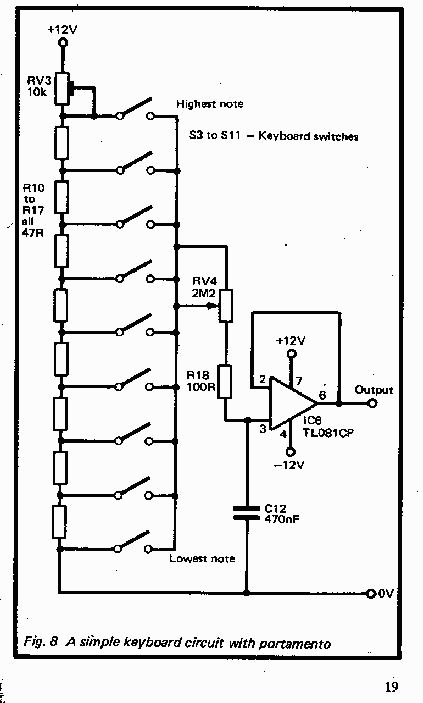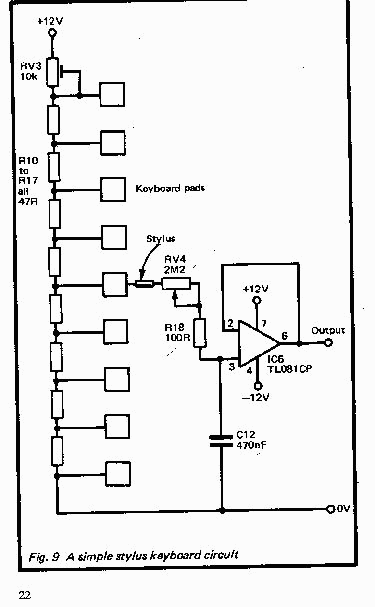<<- Back ^- Intro -^ Forward ->>
Chapter 2: Keyboard
THE KEYBOARD
Keyboard circuits can be quite complex and difficult to set up, but good results can be obtained using a very basic type such as the one shown in the circuit diagram of Figure 8.
The first requirement is for a potential divider to generate all the voltages for the required notes. These voltages are provided by RV3 plus R10 to R17, but only eight fixed resistors are shown in Figure 8 for the sake of clarity. In practice this resistor chain must include one less fixed resistor than there are notes on the keyboard. Most keyboards available to the home constructor seem to be four or five octave types, which require 48 and 60 resistors respectively. The use of a logarithmic VCO means that all the resistors must be of the same value, and there is no need to use any unusual and difficult to find values. In fact the exact value used is not critical, but it must not be too low or the resistor chain will draw a high supply current. On the other hand, using a high value could result in the keyboard circuit being unable to drive the subsequent circuitry properly, and could also give problems with excessive stray pick up of mains “hum” or other electrical noise. A value of 47 ohms seems to be a good compromise. Ideally the keyboard resistors should have a tolerance of 0.5% or better, but suitable components might prove to be difficult to obtain, and very expensive if a suitable source can be located. Good results should be obtained using resistors having a tolerance of 1%, and these are readily available at quite low cost.
RV3 is adjusted so that there is 83.33 millivolts across each resistor, or 1 volt per 12 resistors in other words. This adjustment does not need to be particularly accurate if the synthesiser is to be used on its own, and RV3 can then be given any setting which enables the VCO to be set up for the correct pitch range. Greater accuracy is needed if the unit is to be used with other synthesisers (which must be of the 1 volt per octave type). In the absence of suitable test gear it is still possible to give RV3 the correct adjustment. First use the keyboard voltage from the other synthesiser to drive the VCO, and set up the VCO for the correct pitch range.
The sample and hold circuit has IC6 as a very high input impedance buffer stage. This is required in order to provide a sufficiently low output voltage to drive one or more VC0s, while providing a high enough input impedance to ensure that there is no significant loading on charge storage capacitor C12. The input impedance of IC6 is about one million rnegohms, and in theory there should be no significant reduction in the charge on C12 over a long period of time. In reality things are less certain, as the leakage resistance of C12 itself plus any leakage through the printed circuit board also have to be taken into account. However, provided C12 is a good quality type such as a carbonate or polyester component, there should be no significant drop in the charge voltage over a period of at least several seconds.
If we assume that RV4 is at minimum resistance, when any keyboard switch is operated C12 is almost instantly charged to the new keyboard voltage, and it retains that charge after the key is released. Adjusting RV4 for increased resistance gives much the same effect, but it takes C12 longer to adjust to each new voltage. This can be used to give a glide from one note to the next, rather than abrupt switching from one note to another. This effect is usually termed “portamento”, but it is also known as “glissando”. The higher the value of RV4, the longer it takes the synthesiser to move on to new notes. However, beware of using an excessive glide time as this could result in the desired notes never being reached.
With its relative simplicity this keyboard circuit inevitably has a shortcoming. With more sophisticated keyboard circuits the lowest note is normally the one that is obtained if more than one key at a time is depressed. With this circuit you will get a more or less random note if more than one key at a time is operated. Of course, this is not really a major drawback, and is perfectly satisfactory provided the keyboard is played reasonably crisply. Certainly no real problems were encountered when playing the prototype. Keyboard Components (Fig. 8)
Resistors R10 to Rl7 47R (1 % or better, quantity to suit keyboard) R18 100R(1/4watt5%) Potentiometers RV3 10k miniature horizontal preset RV4 2M2 linear Capacitors C12 470nF miniature polyester Semiconductors IC6 TLO81CP or LF351 Miscellaneous Printed circuit board Keyboard with materials for key contacts Wire, control knob, etc.
Stylus Keyboard
One advantage of this ultra-simple keyboard arrangement is that it can easily be applied to a stylus type keyboard. This is not a keyboard at all in the true sense, but is a printed circuit board etched with a miniature keyboard type pattern. Touching a stylus of some kind onto one of the “keys” completes an electrical contact and plays the required note. This type of keyboard is more difficult to use than a conventional type, but it does have a very large advantage in that it can be constructed for only a small fraction of the cost of a real keyboard.
Figure 9 shows the stylus keyboard circuit, and this only differs from the original in that the keyboard switches have been replaced by the keyboard pads and the stylus. The latter can be ,something like a test prod or a 4 millimetre plug., Keep the keyboard pads well cleaned so that a good electrical contact can easily be made to them.

